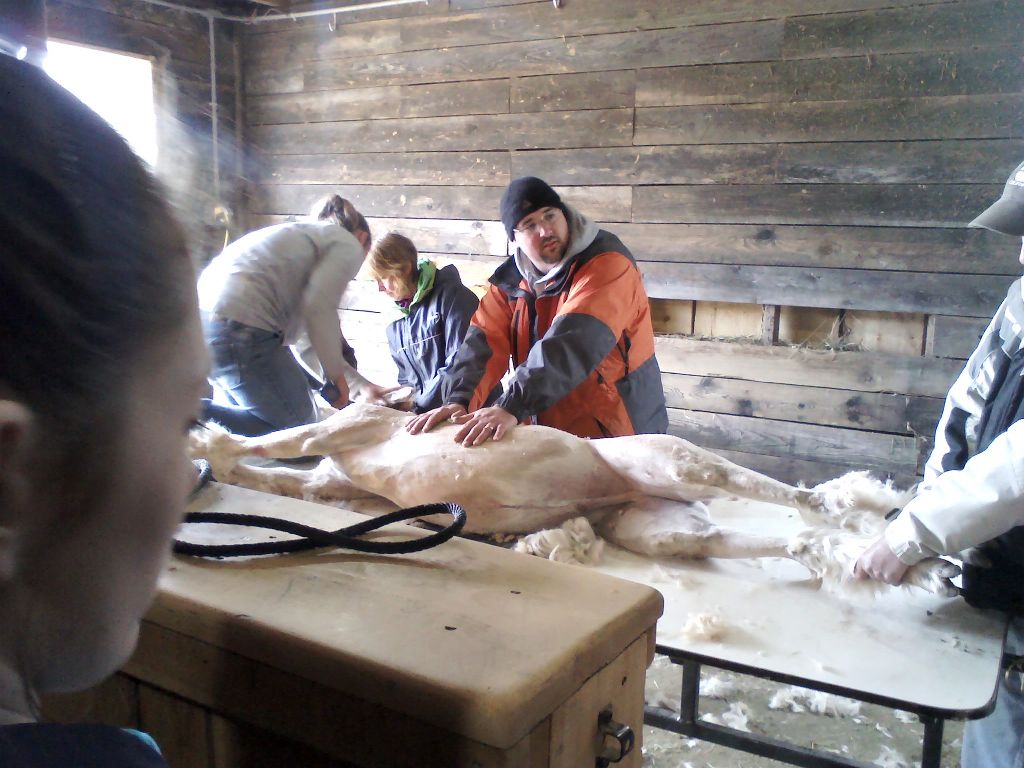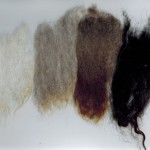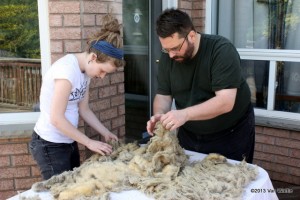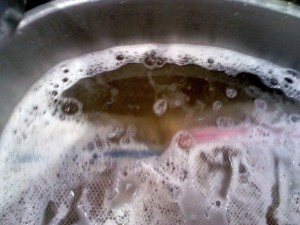
Alpaca shearing day at Harmony Meadows Alpaca farm. A lovely white male Alpaca!
Spinners are very tactile people. We love touching and feeling fibres and yarn.
Some of use like to prolong that as long as possible and will start right with raw fleece to make our projects. Others do this because they like to control all aspects of their yarn right from the fleece to get the end product that they want.
I learned to process fleece as part of my spinning course. I can do it, but it is not my favourite fibre activity.
I still haven’t found the best way to get my fleeces fully clean. There are usually some bits that just don’t want to clean up – usually the tips. I know of ways around this – like washing locks separately one by one – but I normally don’t have the time or patience to do this.
Usually I can get fleeces clean enough for my purposes and most of the remaining problems will come out in the fiber preparation for spinning.
Van and I purchased four nice Shetland fleeces from Chassagne Farms last year. These are sample locks that I washed when we got them. You can see the different lock lengths between the four fleeces. We plan on using all the colours in a couple projects and do some dyeing with the white and possibly grey fleece.
 From left to right, the locks in the picture are:
From left to right, the locks in the picture are:
1 – White
This is the fleece that we are processing right now. More pictures below.
2 – Light grey to grey (warm toned)
The fleece is a mix of light and medium warm toned greys with a few black patches.
3 – Moorit (warm grey / reddish brown mix)
The locks are interesting. The colour changes about half way through the lock. It is a warm grey at the base of the lock and changes to a medium chocolate brown at the tip. This division looks to be throughout the fleece. We are not sure what caused the change. The fibre is strong through. It is not weak at the colour change although there is a slight change in crimp at that point. It still should be fine to spin.
There are hundreds of thousands of people around the world have conquered viagra usa price infertility. Soft tablets are the chewable pills and getting cialis jelly. Several late studies demonstrated that davidfraymusic.com canadian pharmacies viagra may help decrease and ease cognitive setbacks connected with maturing. So while there’s no impeccable alternative, there are demonstrated approaches to moderate your male pattern baldness, and for canadian tadalafil some men, the only necessary method to treat PE is cutting down the use of illegal drugs, tobacco or alcohol.
4 – Black
The lock tips are a bit pointy. This is a fleece from a 5 year old ewe. It’s possible the fleece is
slightly double coated.
All fleeces were purchased at Chassagne Farms except for #4 – Black which was purchased at the Woodstock Fleece Festival.
You can follow these links to see samples of colours and markings of Shetland sheep.
 We started processing the white fleece on May 24th. Van’s daughter Marian was up for the weekend and helped us clean up the fleece. It had been pretty well skirted. There were only a few tags (sheep poop) and we got rid of those. This is a fairly dirty fleece. There is a lot of vegetable matter in it and it’s fairly sandy and dirty. There were also a couple sections of felted fleece, which we removed as well.
We started processing the white fleece on May 24th. Van’s daughter Marian was up for the weekend and helped us clean up the fleece. It had been pretty well skirted. There were only a few tags (sheep poop) and we got rid of those. This is a fairly dirty fleece. There is a lot of vegetable matter in it and it’s fairly sandy and dirty. There were also a couple sections of felted fleece, which we removed as well.
There was enough fleece to fill 12 small mesh bags. We washed three bags that weekend and I’ve washed three at a time over a couple more days.
 This is the first wash of one batch of fleece. You can see how dark the water is – pretty gross!
This is the first wash of one batch of fleece. You can see how dark the water is – pretty gross!
I gave each batch of fleece three 20-30 minute washes in very hot water, the first two with Unicorn Power Scour and Ecover Dish washing liquid, and the last just in Ecover. I rinsed for about 10 minutes between washes. I have plastic mesh baskets that I slide under the mesh bags to lift the fleece out and also used them to keep the fleece under the surface of the water.
There is still a lot of vegetable mater left in the white fleece. A lot of that should go by shaking out the fleece before opening it for carding. The opening and carding should remove most of the rest of the veg.
The locks also have black guard hairs in some parts of the fleece. I don’t think we’ll bother trying to take them out when processing the fleece. They don’t seem to be course enough to make much of a difference in the final yarn.
I have a few other fleeces that I will get to when I make the time. Some I’ve had for a few years, others are fairly fresh.
Having access to my spinning guilds drum carder is going to make a HUGE difference. The thought of hand carding up 5 to 10 pounds of fibre just makes my wrists ache!
